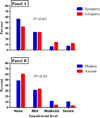Allopatric tuberculosis host-pathogen relationships are associated with greater pulmonary impairment
- PMID: 23501297
- PMCID: PMC4582658
- DOI: 10.1016/j.meegid.2013.02.015
Allopatric tuberculosis host-pathogen relationships are associated with greater pulmonary impairment
Abstract
Background: Host pathogen relationships can be classified as allopatric, when the pathogens originated from separate, non-overlapping geographic areas from the host; or sympatric, when host and pathogen shared a common ancestral geographic location. It remains unclear if host-pathogen relationships, as defined by phylogenetic lineage, influence clinical outcome. We sought to examine the association between allopatric and sympatric phylogenetic Mycobacterium tuberculosis lineages and pulmonary impairment after tuberculosis (PIAT).
Methods: Pulmonary function tests were performed on patients 16 years of age and older who had received ≥20 weeks of treatment for culture-confirmed M. tuberculosis complex. Forced Expiratory Volume in 1 min (FEV1) ≥80%, Forced Vital Capacity (FVC) ≥80% and FEV1/FVC >70% of predicted were considered normal. Other results defined pulmonary impairment. Spoligotype and 12-locus mycobacterial interspersed repetitive units-variable number of tandem repeats (MIRU-VNTR) were used to assign phylogenetic lineage. PIAT severity was compared between host-pathogen relationships which were defined by geography and ethnic population. We used multivariate logistic regression modeling to calculate adjusted odds ratios (aOR) between phylogenetic lineage and PIAT.
Results: Self-reported continental ancestry was correlated with Mycobacterium. tuberculosis lineage (p<0.001). In multivariate analyses adjusting for phylogenetic lineage, age and smoking, the overall aOR for subjects with allopatric host-pathogen relationships and PIAT was 1.8 (95% confidence interval [CI]: 1.1, 2.9) compared to sympatric relationships. Smoking >30 pack-years was also associated with PIAT (aOR: 3.2; 95% CI: 1.5, 7.2) relative to smoking <1 pack-years.
Conclusions: PIAT frequency and severity varies by host-pathogen relationship and heavy cigarette consumption, but not phylogenetic lineage alone. Patients who had disease resulting from allopatric-host-pathogen relationship were more likely to have PIAT than patients with disease from sympatric-host-pathogen relationship infection. Further study of this association may identify ways that treatment and preventive efforts can be tailored to specific lineages and racial/ethnic populations.
Copyright © 2013 Elsevier B.V. All rights reserved.
Conflict of interest statement
The authors have no significant conflicts of interest with any companies or organizations whose products or services maybe discussed in this article.
Figures
References
-
- Baena A, Leung JY, Sullivan AD, et al. TNF-alpha promoter single nucleotide polymorphisms are markers of human ancestry. Gene. Immun. 2002;3(8):482–487. - PubMed
-
- Blaser MJ, Kirschner D. The equilibria that allow bacterial persistence in human hosts. Nature. 2007;449(7164):843–849. - PubMed
-
- Blumberg HM, Burman WJ, Chaisson RE, et al. American Thoracic Society/Centers for Disease Control and Prevention/Infectious Diseases Society of America: treatment of tuberculosis. Am. J. Respir. Crit. Care Med. 2003;167(4):603–662. - PubMed
-
- Boelaert JR, Gomes MS, Gordeuk VR. Smoking, iron, and tuberculosis. Lancet. 2003;362(9391):1243–1244. - PubMed
MeSH terms
Grants and funding
LinkOut - more resources
Full Text Sources
Other Literature Sources


